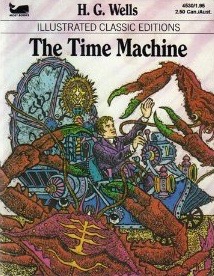Oh, Beth of December 2019, you had no idea what was coming. You went and signed up for a bunch of challenges again, and then… well. Let’s round ’em up!
Back to the Classics (hosted by Books and Chocolate)
Goal: 12 books
Result: 5 (42%)
Yes, I did use the maximum of 3 children’s books. Still considerably better than last year.
- 19th Century Classic (1800-1899): Looking Backward: 2000-1887 by Edward Bellamy (1888) (12/29/20)
- 20th Century Classic (1900-1970): Basil and the Lost Colony (1964) by Eve Titus (1/27/20)
- A Genre Classic: The Time Machine by H.G. Wells (1/29/20)
- Classic with a Person’s Name in the Title: Tales from Shakespeare by Charles & Mary Lamb (12/31/20)
- Classic with a Place in the Title: Basil of Baker Street (1958) by Eve Titus (1/25/20)
Classic by a Woman AuthorClassic in TranslationClassic by a Person of ColorClassic with Nature in the TitleClassic About a FamilyAbandoned ClassicClassic Adaptation
Georgian Reading Challenge (hosted by Becky’s Book Reviews)
Goal: 4 books
Result: 1 (25%): Tales from Shakespeare by Charles & Mary Lamb (1807)
Victorian Reading Challenge (hosted by Becky’s Book Reviews)
Goal: 20 books
Result: 1 (5%)
- JANUARY/FEBRUARY – JOURNEYS and TRAVELS: The Time Machine by H. G. Wells (1895)
FEBRUARY/MARCH – LOVE and MARRIAGEMARCH/APRIL – SECOND CHANCESAPRIL/MAY – NAMES AS TITLESMAY/JUNE – LONG TITLE OR LONG SUB-TITLESJUNE/JULY – ADAPTATIONSJULY/AUGUST – FAVORITE AUTHORS, NEW-TO-ME BOOKSAUGUST/SEPTEMBER – BACK TO SCHOOLSEPTEMBER/OCTOBER – CRIME OR TRUE CRIMEOCTOBER/NOVEMBER – HOME AND FAMILYNOVEMBER/DECEMBER – COMFORT READS
Read Harder (Book Riot)
Goal: 24 Books
Result: 19 (79%)
- A YA nonfiction book: Flowers in the Gutter by K.R. Gaddy
- A retelling of a classic of the canon, fairy tale, or myth by an author of color: A Study in Scarlet Women by Sherry Thomas
- A mystery where the victim(s) is not a woman: The Alienist by Caleb Carr
- A graphic memoir: Spinning by Tillie Walden
- A book about a natural disaster: The Thief of Worlds by Bruce Coville
A play by an author of color and/or queer author- A historical fiction novel not set in WWII: The Deep by Alma Katsu
- An audiobook of poetry: Sir Gawain and the Green Knight, translated by Simon Armitage, read by Bill Wallis
- The LAST book in a series: The Tower of Nero (The Trials of Apollo #5) by Rick Riordan (This one was Maureen Johnson’s The Hand on the Wall, but then she announced a forthcoming fourth book!)
- A book that takes place in a rural setting: The Lost Man by Jane Harper
- A debut novel by a queer author: Red, White & Royal Blue by Casey McQuiston
- A memoir by someone from a religious tradition (or lack of religious tradition) that is not your own: Educated: A Memoir by Tara Westover
A food book about a cuisine you’ve never tried before- A romance starring a single parent: Courting the Countess by Jenny Frame
A book about climate changeA doorstopper (over 500 pages) published after 1950, written by a woman- A sci-fi/fantasy novella (under 120 pages): The Time Machine by H.G. Wells
- A picture book with a human main character from a marginalized community: Double Bass Blues by Andrea J. Loney
- A book by or about a refugee: Other Words for Home by Jasmine Warga
- A middle grade book that doesn’t take place in the US or the UK: Sherlock Sam and the Missing Heirloom in Katong by A.J. Low
- A book with a main character or protagonist with a disability (fiction or non): Song for a Whale by Lynne Kelly
- A horror book published by an indie press: The Southern Book Club’s Guide to Vampire Slaying by Grady Hendrix
An edition of a literary magazine (digital or physical)- A book in any genre by a Native, First Nations, or Indigenous author: I Can Make This Promise by Christine Day
Reading Women (Reading Women podcast)
Goal: 24 Books
Result: 8 (33%)
Book by an Author from the Caribbean or IndiaA Book Translated from an Asian LanguageA Book about the Environment- A Picture Book Written/Illustrated by a BIPOC Author: Sulwe by Lupita Nyong’o, illustrated by Vashti Harrison
A Winner of the Stella Prize or the Women’s Prize for Fiction- A Nonfiction Title by a Woman Historian: Flowers in the Gutter by K.R. Gaddy
- A Book Featuring Afrofuturism or Africanfuturism: The City We Became (Great Cities #1) by N.K. Jemisin
An Anthology by Multiple AuthorsA Book Inspired by Folklore- A Book about a Woman Artist: The Anatomist’s Wife by Anna Lee Huber
Read and Watch a Book-to-Movie AdaptationA Book about a Woman Who Inspires YouA Book by an Arab WomanA Book Set in Japan or by a Japanese AuthorA BiographyA Book Featuring a Woman with a DisabilityA Book Over 500 Pages- A Book Under 100 Pages: What is Given from the Heart by Patricia McKissack, illustrated by April Harrison
A Book That’s Frequently Recommended to You- A Feel-Good or Happy Book: Red, White & Royal Blue by Casey McQuiston
A Book about Food- A Book by Either a Favorite or a New-to-You Publisher: To Fetch a Felon by Jennifer Hawkins (Berkley Publishing Group)
- A Book by an LGBTQ+ Author: Spinning by Tillie Walden
A Book from the 2019 Reading Women Award Shortlists (Nonfiction | Fiction) or Honorable MentionsBONUS: A book by Toni MorrisonBONUS: A book by Isabel Allende
I suspect I read some things that satisfied a couple more of those Reading Women tasks.
Overall, I did way better than last year, which actually surprised me a little bit. 2020 was quite a year, y’all.

